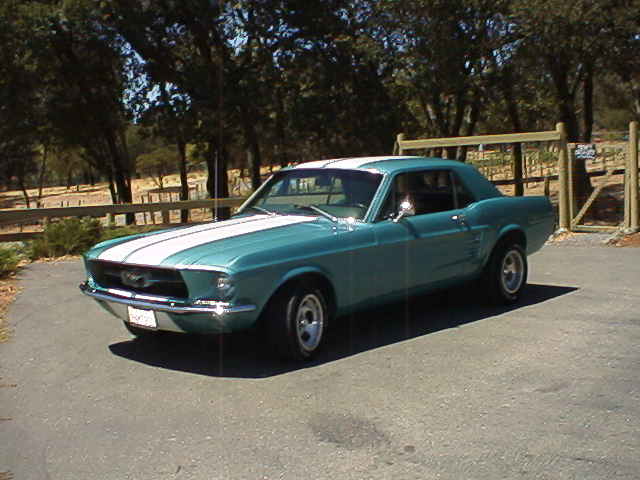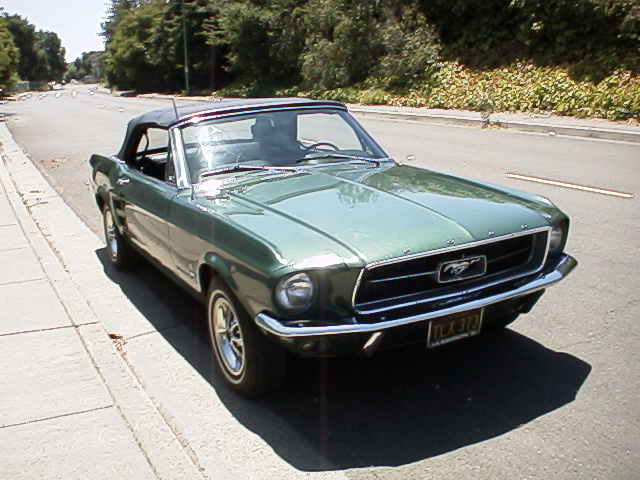
World Classic Autos Index > Guides Index > Ford Mustang
Ford Mustang
1st Generation
When the Mustang was launched on April 17 1964, what became known as ‘America's sports car’ was born. The car was unique with a long hood, low roof line, sculpted bodysides and short rear boot and more importantly affordable. The base model sold for $2,372 which was 20% less than its predecessor the Thunderbird. Between its launch and August 65 the car was selling at seven times its projected rate. By March 1966 the millionth Mustang was sold.
The success of the Mustang prompted other American manufactures to reply with competing cars like AMC's Javelin and AMX, GM's Camaro and Firebird, and Chrysler’s Baracuda and Challenger.
Only the Camaro and Firebird remain to challenge the sales tallies of the Mustang, rather weakly, at that. Now GM has announced the discontinuation of the Camaro, after 37 years the Mustang will be the sole affordable American muscle car on the market.
1965 - 1966
Although launched in April 1964 all the first models were 65 models. There were some differences between the early models and these are sometimes referred to as 1964½ models. From its very outset the Mustang was offered with an extenive option list, this means that it is possible to never see two Mustangs alike.
Standard equipment the 170ci Falcon 6 cylinder engine and 3 speed manual gearbox, full wheel covers, padded dash, bucket seats and carpeting. Gearbox options included auto, 4 speed manual or 3 speed with overdrive. Engine option included 3 variants of V8 engine.
In addition there were a variety of packages available
- Rally-Pac
- Tachometer and clock
- Special Handling
- Power brakes
- Visibility Group Options
- Outside rear view mirrors
- Accent Group Options
- Pin striping, rocker panel mouldings
- Instrument Group Options
- Needle gauges, circular speedo
- GT Group options
- Disc brakes, driving lights and special trim
- Handling Package
- Stiffer springs and shocks, faster steering, 5.90 x 15 tyres
- Other options
- Power steering, air-con, centre console, deluxe steering wheel, vinyl roof covering, push button radio, knock-off style wheel covers,
The original 170ci engine was dropped in September 1964 and this is considered the changeover point for 1964½ and 1965 models. It was replaced with a 200ci 6 cylinder engine with 120 bhp rather than 101 bhp.
In V8 form engines were orinally a 260ci, a 289ci (2 barrel carb - 195 bhp/ 4 barrel carb - 210) and a Hi-performance 289ci with 271 bhp. From September 1964 the 260ci was discontinued and the 4 barrel 289 was boosted to 225 bhp. These bhp figures were Fords and overestimated their true power. However there were many extras available to boost the power of the 271ci to over 300 bhp.
As far as body styles go, it was originally available as a hardtop and convertible. September 1965 saw the introduction of the 2+2 fastback which had a fold down rear seat.
Differences between the 1965 and 1966 model were minimal and decorative. For example the single horizontal grille bar was replaced by several thin bars. The GT used a 65 grille bar but with auxiliary driving lamps. Inside all with the instrumentation as per the 65 GT models.
1967 - 1968
By now the Mustang had competition and Ford replied with more cubic inches. A 390ci 320 bhp was now fitted. It was really too heavy for the car and needed the competition handling package that was available. However 0 - 60 mph in 7.3 secs was an attractive proposition.
| Ford Mustang 1967 Hardtop | Ford Mustang 1967 Convertible |
|---|---|
 |
 |
The body style wasn't completely new but was wider and longer. These changes were most notable on the fastback models. However the Mustang though more economical and with a better engines than its rivals was beginning to look dated and sales plummeted in 1968.
There were a few cosmetic changes on 68 models, but the engines had to be altered to meet Federal emissions legislation. The bhp on the 200ci dropped to 115, the 2 barrel 289ci down to 195. The higher powered 289ci gave way to a 302ci and produced 230 bhp. A 427ci (390 bhp) was also available. Ford introduced a number of safety features on the 1968 models including, dual-circuit brakes, retractable front and rear seat belts, hazard warning lights and laminated windscreen.
Thirty Three Years On
In 1968 Steve McQueen starred in a film called Bullitt. In case you missed it, its famous for an eight-minute car chase between a fastback Mustang GT and a Dodge Charger through the streets of San Francisco. In 2001 Ford have brought out a Mustang GT coupe, complete with 60s-look instrument panel, aluminium pedals, and leather trim seats. At a price of $26830 you get 265 ponies under the hood. To improve road holding its boasts lowered suspension and better brakes. Externally they can be spotted by the special side scoops and 17-inch five-spoke aluminium wheels. Only 6500 will be built and according to Ford for one year only. By the way you can have it in any color you like from a list of three but we all know which will be the most popular.
1969 - 1970
Another restyle came with the 1969 models. Although it maintained the original wheelbase, dimensions increased all round. As a result the car actually handled better than its predecessers. The Cobra Jet Mach 1 and the Boss 302 versions were the fastest non-Shelby Mustangs to date.
The 1969 Mustang is easily distinguished by its quad headlamp arrangement and lack of side body sculpture. The basic line up of hardtop, fastback and convertible continued but with the addition of new variations. The Grande hardtop was aimed at the luxury end of the market. Available as both a six and eight cylinder form it came with a vinyl roof and a fake teak wood interior. Also available was the Mach 1 with a 250 bhp 352ci V8 which could give a Camaro Z28 a run for its money.
The base V8 was a 302ci with 220 bhp and the biggest was the Cobra Jet 428 available with or without Ram-Air injection. The Cobra Jet had originally been developed for drag racing and could take the Mustang from a standing start to the quarter mile in about 13.5 seconds. A Boss 302 engine had become available in early 1969 to compete with the Z28s in the Trans-Am Challenge Race series. Its bhp was limited to 290 but could be developed to 400.
Through 69-70 the emphasis for Mustangs was on performance rather than luxury. A Boss 429 was available and was probably the best ever Mustang. It was fitted with Ford's Cobra Jet NASCAR racing engine!!
1971 - 1973
It should be remembered that this variant of the first generation Mustang was designed before the fuel crisis of the 70s and hence it became larger rather than more economical.
The car was 8 inches longer, 6 inches wider and almost 600lbs heavier than the 1965 model. The number of engines offered was reduced, but included a Boss 351 delivering 330 bhp and 429 Cobra Jet which could take this heavy beast from 0 - 60 mph in 6.5 seconds.
Sales continued to fall and as the second generation was not long off Ford did little to alter the range, except as dictated by Federal requirements. There continued to be a wide range of options but now these focused on body trim, for example the vinyl roof could be ordered in 6 different colors.
Shelby Mustangs
These are the most desirablr and sought after of all Mustangs, particularly the early ones. The early Shelbys were specially built to be modified by the Shelby factory. Each car to be converted was delivered as a white fastback with a black interior, 271 bhp Hi-Performance engine and four speed manual gearbox and a Ford Galaxie rear end. These Mustangs were delivered without hood/bonnet, exhaust system or rear seats.
At Shelby they received extensive suspension modifications, Koni shock absorbers, aluminium intake manifolds, special Holley carb, large front anti-sway bar and a glass fibre hood with air scoop. Inside there were 3 inch competition seat belts, rev counter and oil pressure gauge mounted at eye level and a flat dish steering wheel. As there were no rear seats the spare was repositioned. All could be identified by stripes which displayed the car's name - GT350. With a 0 - 60 mph performance of 6.5 seconds and a top speed of 135mph they were very desirable cars.
The changes for the 1966 models were brought about by demand from consumers rather than improvement from Shelby himself. The first 1966 models were in fact left overs from 1965 models. When 1966 production did begin, color choices were available in red, green and black. A fold-down rear seat now became an option.
Due to the increase in weight of the 67 model the front end of the GT350 became fibre glass. Power steering and power brakes became mandatory options. Internally they were fitted with a roll-over bar and intertia-reel shoulder harnesses. A new Shelby was introduced, the GT500 with a 355bhp engine.
By 1968 Shelby had little interest in the Mustang for a number of reasons. The A O Smith Company was contrated out to carry out Shelby conversions. The 68 model received a new front end. The GT350 used Ford's 302ci engine. Luxury options like auto gearbox, air-con could be specified. By mid-year the 428ci engine was replaced by the 428 Cobra Jet unit and cars with this engine were called GT500KR ('King of the Road') and replaced the GT500.
The Mustang changed in 1969 and the Shelby changed with it. The front end was extended and spoiler added. The GT350 received the 351 engine and the KR designation was dropped from the GT500. At the end of the 1969 model year Carroll Shelby asked for the programme to be terminated. Today they are the most desirable Mustangs.
Books
Standard Catalog of Ford 1903-2003 UK USA (*Ad)
Standard Catalog of Mustang 1964 - 2004 USA (*Ad)
Parts
More Guides | VIN Identification | Thunderbird | Ford Car Links | Books | Magazines | Pictures | Values